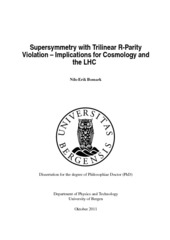| dc.contributor.author | Bomark, Nils-Erik | eng |
| dc.date.accessioned | 2012-01-09T09:55:45Z | |
| dc.date.available | 2012-01-09T09:55:45Z | |
| dc.date.issued | 2011-12-16 | eng |
| dc.identifier.isbn | 978-82-308-1922-7 (print version) | en_US |
| dc.identifier.uri | https://hdl.handle.net/1956/5376 | |
| dc.description.abstract | The current Standard Model of particle physics is sometimes referred to as one of the most successful theories ever constructed. When looking at the precision with which its predictions are being confirmed, it is easy to agree. Yet no theoretical particle physicist is content with the state of affairs. Some of the reasons for the dissatisfaction is the non-observation of the Higgs boson, a vital part of the Standard Model, as well as the theoretical problems associated with it. Most obvious, though, is the fact that most of the matter density of the universe comes in a form that cannot be associated with any part of the Standard Model. The nature of this dark matter is one of the most discussed questions in the field. Many of the speculations beyond the Standard Model are going in the direction of supersymmetry, a symmetry that mixes internal symmetries with spacetime symmetries in a non-trivial way and in the process introduces a symmetry between fermions and bosons. Due to problems with too fast proton decay and possible presence of other exotic processes, one usually assumes that R-parity is conserved when studying supersymmetric models. This, however, is not necessary and the inclusion of R-parity violating couplings have interesting implications for the phenomenology both within cosmology and LHC physics. If R-parity is violated, one has to abandon the neutralino as the dark matter candidate, but there is a perfectly valid alternative in the gravitino. Gravitino dark matter that (very slowly) decays, might be a source of measurable cosmic rays. In fact, the recent anomalies in cosmic ray positrons and electrons, seen by PAMELA and Fermi LAT, can be well described by decay products from gravitino dark matter. Unfortunately, the corresponding gamma ray signal was not seen by the Fermi LAT telescope and although this does not exclude gravitinos as the source of the cosmic ray anomalies, it makes it less likely to be the correct answer. It is also worth noticing that the gravitational nature of the gravitino interactions suppresses the decay rate enough to, in some cases, allow R-parity violating couplings in the neighborhood of the experimental limits, without coming in conflict with cosmic ray measurements. This, however, requires a light (GeV scale) gravitino and a coupling that does not allow a loop decay. For LHC physics, the implications from violating R-parity can be paramount. However, the most likely scenario might still be pair production of squarks and gluinos, followed by a cascade decay down to the neutralino. If the R-parity violating couplings are large enough, the neutralino will then decay to three Standard Model particles. This gives rise to multi-jet and/or multi-lepton finals states. This is in general promising for detection since the detection of especially leptons is much easier than measuring missing transverse energy as is required in R-parity conserving supersymmetric models. The large number of invariant mass distributions are also very useful in determining the couplings and measure the neutralino mass. All relevant invariant mass distributions can be calculated theoretically, at least to a good approximation, and then compared to data. For trilinear R-parity violating couplings, it is shown that, due to our good knowledge of the expected invariant mass distributions, it is clearly possible to identify most couplings responsible for the decay of the neutralinos. Some problematic cases remain due to combinatorial jet background, the presence (and associated information-loss to neutrinos) of taus in the final state as well as phase-space suppression of channels with top quarks. | en_US |
| dc.language.iso | eng | eng |
| dc.publisher | The University of Bergen | en_US |
| dc.relation.haspart | Paper I: N.-E. Bomark, S. Lola, P. Osland, A.R. Raklev. Gravitino dark matter and the flavour structure of R-violating operators, Physics Letters B 677(1–2): 62–70, June 2009. Full text not available in BORA due to publisher restrictions. The article is available at: <a href="http://dx.doi.org/10.1016/j.physletb.2009.05.011" target="blank"> http://dx.doi.org/10.1016/j.physletb.2009.05.011</a> | en_US |
| dc.relation.haspart | Paper II: N.-E. Bomark, S. Lola, P. Osland, A.R. Raklev. Photon, neutrino and charged particle spectra from R-violating gravitino decays, Physics Letters B 686(2–3): 152–161, March 2010. Full text not available in BORA due to publisher restrictions. The article is available at: <a href="http://dx.doi.org/10.1016/j.physletb.2010.02.050" target="blank"> http://dx.doi.org/10.1016/j.physletb.2010.02.050</a> | en_US |
| dc.relation.haspart | Paper III: N.-E. Bomark, C. Debajyoti, S. Lola, P. Osland, Flavour structure of R-violating neutralino decays at the LHC. Journal of High Energy Physics 70(7), July 2011. The article is available at: <a href="http://hdl.handle.net/1956/5225" target="blank">http://hdl.handle.net/1956/5225</a> | en_US |
| dc.title | Supersymmetry with Trilinear R-Parity Violation – Implications for Cosmology and the LHC | en_US |
| dc.type | Doctoral thesis | |
| dc.rights.holder | Copyright the author. All rights reserved | en_US |
| dc.subject.nsi | VDP::Mathematics and natural science: 400::Physics: 430::Nuclear and elementary particle physics: 431 | en_US |
